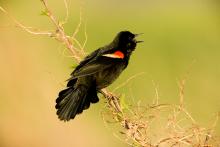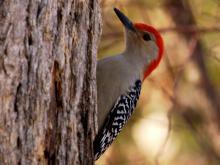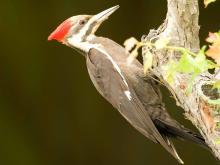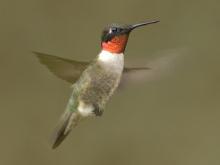Birds
Media

Species Types
Scientific Name
Agelaius phoeniceus
Description
These crimson-shouldered residents of marshes, wet meadows and weedy roadside ditches are well-known by most rural Missourians. Their “konk-o-REEE” song likely emanates from every pond in Missouri.
Media

Species Types
Scientific Name
Cathartes aura
Description
The turkey vulture is perhaps the most commonly seen soaring bird in our state. Identify this "buzzard" from below by its shallow V-angled wing posture and two-toned pattern, with the forward edge of the wings black and the trailing half gray or silvery.
Media

Species Types
Scientific Name
Dryobates pubescens (formerly Picoides pubescens)
Description
Downy woodpeckers are ornately decorated with black-and-white upperparts and white underparts. They are often seen foraging for insects on tree bark or visiting suet feeders.
Media

Species Types
Scientific Name
Cardinalis cardinalis
Description
The male northern cardinal is a bright red bird with a head crest and black mask. An excellent singer, this familiar backyard bird is beloved by many.
Media

Species Types
Scientific Name
Melanerpes erythrocephalus
Description
A flurry of black-and-white wingbeats and a bright, all-red head announce the presence of the red-headed woodpecker. The voice is a loud, descending “kweeer.”
Media

Species Types
Scientific Name
Melanerpes carolinus
Description
A striking woodpecker with grayish white face and underparts, black-and-white banded upperparts, and a red band on the head or nape. The red belly is often not noticeable.
Media

Species Types
Scientific Name
Dryocopus pileatus
Description
The large, crow-sized pileated woodpecker often attracts attention with its loud, resonant drumming high in trees. Confirm your observation by noting its black body with white markings and its red topknot.
Media

Species Types
Scientific Name
Pheucticus ludovicianus
Description
The rose-breasted grosbeak's song is a beautiful, robin-like carol. Grosbeaks are chubby birds with heavy bills used for gathering and eating beetles, seeds, and fruits.
Media

Species Types
Scientific Name
Sphyrapicus varius
Description
Their mottled back pattern camouflages them on tree trunks, but yellow-bellied sapsuckers leave behind telltale small, weeping holes in trees.
Media

Species Types
Scientific Name
Archilochus colubris
Description
The ruby-throated hummingbird, a tiny bird with a long needlelike bill, is well-known and beloved. It hovers and flies forward and backward with a humming sound. In the light, the male's ruby-red throat shines like a jewel.
See Also







Media

Species Types
Scientific Name
Hemaris diffinis
Description
The snowberry clearwing is a moth that confuses people because it looks like a bumblebee and flies like a hummingbird!
Media

Species Types
Scientific Name
Hyles lineata
Description
The white-lined sphinx moth sometimes confuses people because it flies, hovers, and eats from flowers like a hummingbird. The adults often fly during daylight hours as well as in the night and are often found at lights.
Media

Species Types
Scientific Name
Darapsa myron
Description
The Virginia creeper sphinx moth is common in woods and brushy areas and comes to lights at night. The larvae eat Virginia creeper and grape leaves.
Media

Species Types
Scientific Name
Perimyotis subflavus (formerly Pipistrellus subflavus)
Description
Tri-colored bats, formerly called eastern pipistrelles, are relatively small and look pale yellowish or pale reddish brown. The main hairs are dark gray at the base, broadly banded with yellowish brown, and tipped with dark brown.
Media

Species Types
Scientific Name
Myotis grisescens
Description
Gray myotises are difficult to distinguish from other mouse-eared bats. A key identifying feature of the gray myotis is that its wing is attached to the ankle and not at the base of the toes. It’s an endangered species.
Media

Species Types
Scientific Name
Myotis lucifugus
Description
The little brown myotis (little brown bat) is one of our most common bats, but populations are declining. White-nose syndrome has taken a heavy toll in northeastern states. This species is now listed as vulnerable across its range.
Media

Species Types
Scientific Name
Myotis sodalis
Description
The Indiana myotis, or Indiana bat, summers along streams and rivers in north Missouri, raising its young under the bark of certain trees. It is an endangered species.
About Birds in Missouri
About 350 species of birds are likely to be seen in Missouri, though nearly 400 have been recorded within our borders. Most people know a bird when they see one — it has feathers, wings, and a bill. Birds are warm-blooded, and most species can fly. Many migrate hundreds or thousands of miles. Birds lay hard-shelled eggs (often in a nest), and the parents care for the young. Many communicate with songs and calls.





















